Bennemann K.H., Ketterson J.B. Superconductivity: Volume 1: Conventional and Unconventional Superconductors; Volume 2: Novel Superconductors
Подождите немного. Документ загружается.


13 Unconventional Superconductivity in Novel Materials 651
then decrease, according to the theory of MHZ [55].
However,at the highest pressures,such large values of
T
K
are required (∼ 10
6
K!) that it was concluded that
the Ce 4f -state must demagnetize within the context
of the Friedel–Anderson model.
An example of the second case is provided by
the La
1−x
Ce
x
system when Th is substituted for
La. With increasing Th concentration y in the
(La
1−y
Th
y
)
1−x
Ce
x
system, the rate of the initial de-
pression of T
c
with Ce concentration passes through
a pronounced maximum and T
c
vs n changes con-
tinuously from curves with negative curvature and
reentrant behavior to curves with positive curvature
and exponential-like shapes [41]. Concomitantly, the
normal state magnetic susceptibility [57] and elec-
trical resistivity [58] evolve continuously from mag-
netic to nonmagnetic behavior.Aselfconsistent anal-
ysis of the rates of the initial depression of T
c
with n
and the value of the specific heat jump at T
c
demon-
strated thatthe MHZ theory provides a good descrip-
tion of the data from T
K
/T
c0
≈ 0.1 to 100 [59,60].
Magnetically-Ordered Superconductors
The series of isostructural ternary rare earth com-
pounds that have been investigated the most ex-
tensively in connection with the interaction be-
tween superconductivity and long-range magnetic
order include the rhombohedral rare earth molybde-
num chalcogenides RMo
6
S
8
and RMo
6
Se
8
(Chevrel
phases), and the tetragonal rare earth rhodium
boridesRRh
4
B
4
[7,8].Thelong-range magnetic order
that many of these compounds exhibit can be traced
in part to the ordered R sublattice. The persistence of
superconductivity, even in the presence of relatively
large concentrations of R ions, can be attributed to
the relatively weak exchange interaction between the
conduction electron spins and the R magnetic mo-
ments. This, in turn, appears to be associated with
transition metal molecular units or “clusters” which,
along with the R ions, are the basic building blocks
of these ternary R phases. The superconductivity is
believed to be primarily associated with the tran-
sition metal d-electrons that are relatively confined
within the clusters and thereby interact only weakly
with the R ions. Equation 13.13 has been used to esti-
mate the magnitude of J for the RRh
4
B
4
compounds
from the depression of T
c
of LuRh
4
B
4
by R impuri-
ties with partially-filled 4f electron shells [61]. The
initial depression of T
c
of LuRh
4
B
4
by Gd impurities,
(dT
c
/dn)
n=0
= −19 K per atomicfractionof Gd inLu,
yields the value |J | =2.3 × 10
−2
eV-atom, assum-
ing N(E
F
)=0.35 states/eV-atom-spin direction [61].
Other ternary R compounds have been investigated
such as RRh
1.1
Sn
3.5
,R
2
Fe
3
Si
5
,RRuB
2
,etc.[7,8].
Antiferromagnetic Superconductors
The coexistence ofsuperconductivity andlong-range
antiferromagnetic order was discovered in the latter
part of the 1970s in the R molybdenum selenides
RMo
6
Se
8
(R = Gd, Tb, and Er) [8,64] and R rhodium
borides RRh
4
B
4
(R = Nd, Sm and Tm) [8, 65] at the
University of California, San Diego, and in the R
molybdenum sulfides RMo
6
S
8
(R = Gd, Tb, Dy and
Er)[8,62] attheUniversityof Geneva.Theoccurrence
of antiferromagnetic ordering of the R magnetic mo-
ments in thesuperconducting state was inferredfrom
a -typeanomalyintheheatcapacityandacusp
in the magnetic susceptibility for the RMo
6
Se
8
com-
pounds[8,64],andfrom afeaturein theupper critical
field H
c2
vs temperature T curve in the RMo
6
S
8
com-
pounds [8,62].Neutron diffraction measurements on
GdMo
6
Se
8
[66] and RMo
6
S
8
compounds with R = Gd,
Tb,and Dy [67] confirmed the antiferromagnetic or-
dering of the sublatticeof R ionsin the Chevrelphase
structure. The magnetic structure consists of alter-
nating ferromagnetic [100] planes in the nearly cubic
R sublattice in which the magnetic moments are par-
allel or antiparallel to the rhombohedral [111] axis.
Plots of the sublattice magnetization vs temperature
for RMo
6
S
8
compounds with R = Gd, Tb,and Dy are
shown in Fig. 13.11 where they are compared with
data for H
c2
vs temperature displayed in the inset of
the figure [63]. There is a clear correlation between
the onset of the sublattice magnetization and the de-
pression of the H
c2
curve below T
N
.
The anomalous depression of H
c2
in the vicin-
ity of T
N
and other properties of antiferromagnetic
superconductors have been addressed by numerous
theories [68].Several mechanisms by means of which
superconductivityis modified by antiferromagnetic
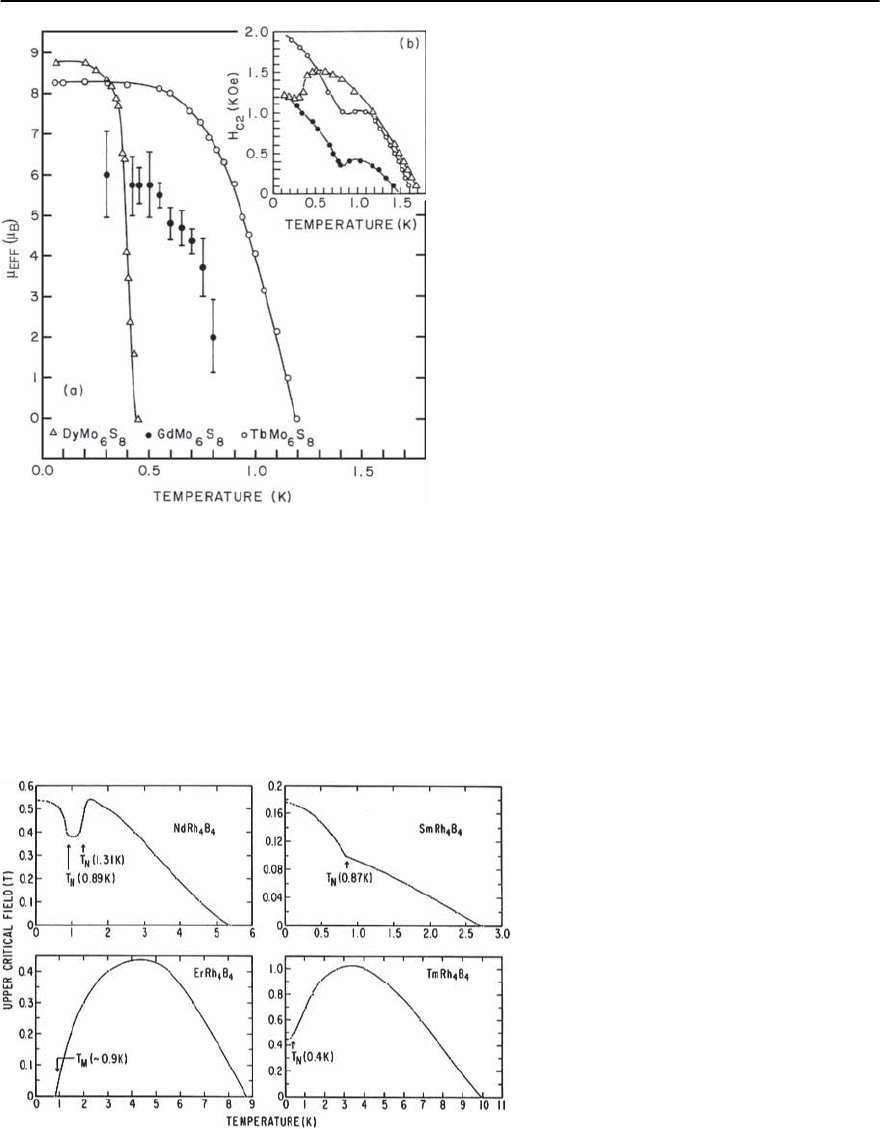
652 M.B. Maple et al.
Fig. 13.11. Temperature dependence of the sublattice mag-
netization for RMo
6
S
8
compounds with R = Gd, Tb, and
Dy. The inset shows the measured upper critical field
H
c2
(T) [62],after [63]
order have been considered. These include: (i) Re-
duction in pair breaking due to the decrease in the
mean magnetization and, in turn, the conduction
electron spin polarization below T
N
. (ii) Increase in
pair breaking due to magnetic moment fluctuations
in the vicinity of T
N
. (iii) Decrease of the attractive
phonon mediated electron–electron pairing interac-
tion by antiferromagnetic magnons. (iv) Reduction
of the available phase space for virtual pair scattering
by the change in lattice periodicity associated with
antiferromagnetic order.(v)Pairingofelectronswith
finite momentum. Finite momentum pairing of elec-
trons in states (k, ↑; k + Q, ↓), where Q corresponds
to translation by a reciprocal lattice vector, was orig-
inally proposed by Baltensperger and Strassler [69]
in 1963,and has been incorporated into several sub-
sequent theories [68].
It should be emphasized that there are some an-
tiferromagnetic superconductorswhere H
c2
actually
increases below T
N
,or, in other words, superconduc-
tivity seems to be enhanced below T
N
.Anotableex-
ample is the compound SmRh
4
B
4
whose resistively
determined H
c2
vs T curve, shown in Fig. 13.12, ex-
hibits a sharp break in slope at T
N
= 0.87 K [9].
In contrast, the H
c2
vs T curves of the other two
RRh
4
B
4
antiferromagnetic superconductors shown
in Fig.13.12 display differentbehaviors with decreas-
ing temperature; for NdRh
4
B
4
, which undergoes two
antiferromagnetic transitions at T
N1
=1.31Kand
T
N2
=0.89K,H
c2
decreases abruptly at T
N1
and then
increases sharply at T
N2
, whereas for TmRh
4
B
4
, H
c2
hardly changes at T
N
= 0.4 K [9]. Neutron diffrac-
tion experiments indicate that the magnetic phases
of NdRh
4
B
4
in zero magnetic field are body-centered
antiferromagnetic structuresin which the Nd
3+
mo-
Fig. 13.12. Resistively determined upper critical
field H
c2
vs temperature T for polycrystalline
samples of NdRh
4
B
4
,SmRh
4
B
4
,ErRh
4
B
4
,and
TmR h
4
B
4
,after[9]
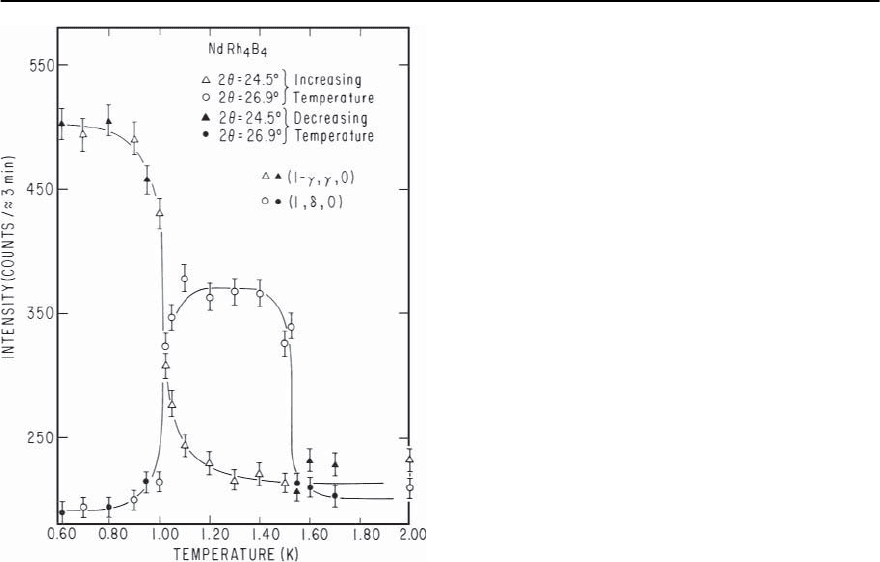
13 Unconventional Superconductivity in Novel Materials 653
Fig. 13.13. Temperature dependence of the neutron scatter-
ing intensity of a representative satellite from each of the
two magnetic phases of NdRh
4
B
4
, after [70]
ments are alternately aligned parallel and antiparal-
lel to the c -axis, with a sinusoidal modulation along
the [100] direction with = 46.5 Å in the high tem-
perature phase, and along the [110] direction with
= 45.2 Å in the low temperature magnetic phase [70].
The temperature dependences of theneutron diffrac-
tion intensity of a representative satellite from each
of the two magnetic phases of NdRh
4
B
4
are shown
in Fig.13.13.The data in Fig.13.12 indicate that there
is no universal behavior of H
c2
vs T for antiferro-
magnetic superconductors. Both enhancements and
depressions of H
c2
are found below T
N
,which appear
to be determined by a combination of the mecha-
nisms enumerated above.
Recently,superconductivity was discoveredin rare
earth transition metal borocarbide quaternary sys-
tems [71–73]. For intermetallic compounds, these
materials have high values of T
c
; T
c
≈ 13.5 K for
YNi
2
B
3
C
0.2
[71], T
c
≈ 16.5 K for RNi
2
B
2
C(R=Y,Tm,
Er, Ho, La) [72], and T
c
≈ 23 K for YPd
5
B
3
C
0.3
[73].
AvalueT
c
≈ 21.5 K was reported for a Th based pal-
ladium borocarbide in the Th-Pd-B-C system which
also has a relatively high extrapolated upper criti-
cal field H
c2
(0) > 17 tesla [74]. Coexistence of su-
perconductivity and antiferromagnetism has been
reported in RNi
2
B
2
C for R = Tm, Er, Ho, Dy [75].
Single crystals of RNi
2
B
2
C compounds have been
prepared and investigated extensively by means of
a variety of experimental techniques [76–79].For ex-
ample,Grigereit and coworkers [78] have performed
neutron scattering measurements on the reentrant
antiferromagnetic superconductor HoNi
2
B
2
Cwhich
becomes superconducting at ∼ 7.5 K, re-enters the
normal conducting state at 5 K, and quickly recov-
ers superconductivity at lower temperature. The ex-
periments reveal that the magnetic order that first
forms upon cooling is oscillatory in nature and is
directly coupled to the superconducting order pa-
rameter. However, in contrast to the ferromagnetic
superconductors (discussed below), the oscillatory
state in HoNi
2
B
2
C is detrimental to superconductiv-
ity, and the superconducting state only survives at
low temperatures because of a first order transition
to a compensated antiferromagnet.A brief review of
the phenomena that arise from the interplay between
superconductivity and magnetism in the RNi
2
B
2
C
compounds can be found in [79].
Ferromagnetic Superconductors
Reentrantsuperconductivity dueto theonsetoflong-
range ferromagnetic ordering of the R magnetic
moments was discovered in 1977 in ErRh
4
B
4
[80]
at the University of California, San Diego, and in
HoMo
6
S
8
[81] at the University of Geneva. These
two materials, which become superconducting at an
upper critical temperature T
c1
, lose their supercon-
ductivity at a lower critical temperature T
c2
≈ T
M
,
where T
M
is the Curie temperature.Thermal hystere-
sis in various physical properties and a spike-shaped
feature in the heat capacity near T
c2
indicate that a
first-order transition from the superconducting to
the ferromagnetic normal state occurs at T
c2
[9].
Typical ac magnetic susceptibility and electrical
resistance vs temperature data for ErRh
4
B
4
are dis-
played in Fig. 13.14 [82]. The thermal hysteresis at
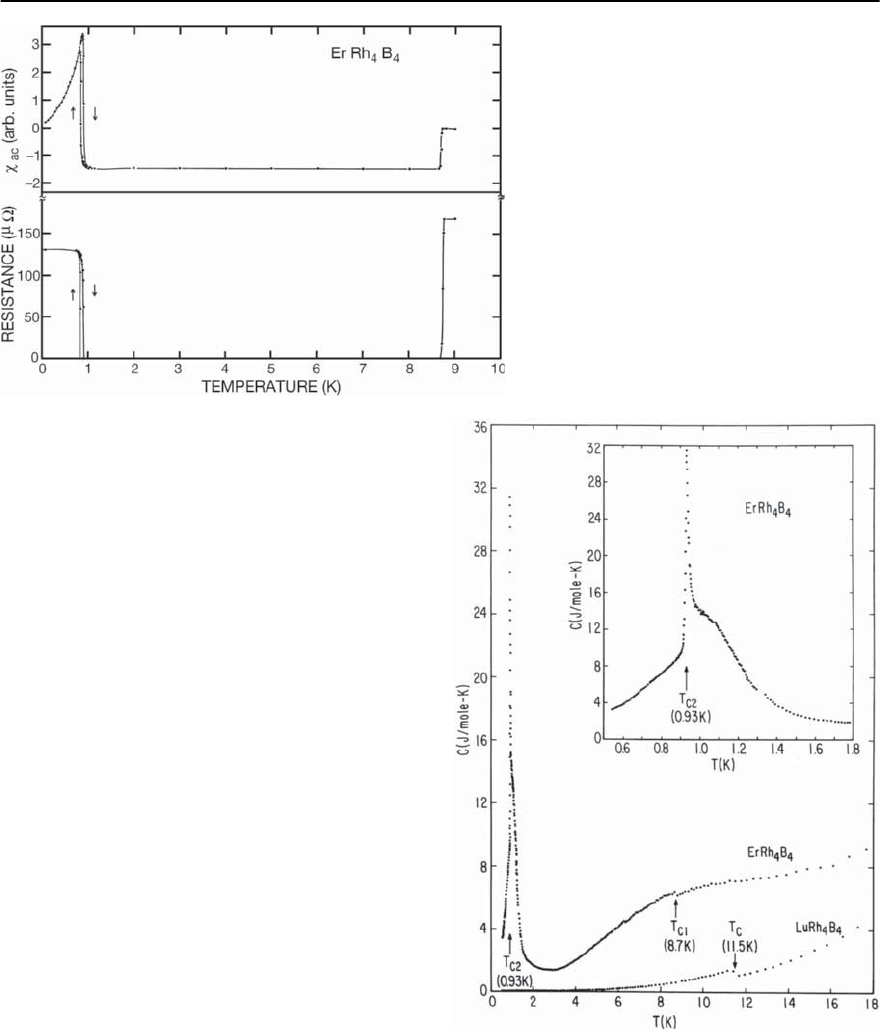
654 M.B. Maple et al.
Fig. 13.14. Typical ac magnetic susceptibility
ac
and electrical resistance vs temperature data for
ErRh
4
B
4
, after [82]
T
c2
is evident in both properties. The resistively de-
termined H
c2
vs T curve for ErRh
4
B
4
is shown in
Fig. 13.12 [9].
Neutron diffraction measurements established
that the groundstatesof thecompounds ErRh
4
B
4
[83,
84]andHoMo
6
S
8
[85] are ferromagnetic.In addition,
small angle scattering studies of ErRh
4
B
4
[84,86]and
HoMo
6
S
8
[87] revealed the existence of asinusoidally
modulated magnetic state with a wavelength of the
order of 100 Å that coexists with superconductivity
in a narrow temperature interval above T
c2
.More-
over, in ErRh
4
B
4
the regions within which supercon-
ductivity and the sinusoidally modulated magnetic
state coexist appear to be interspersed with normal
ferromagnetic domains to form a spatially inhomo-
geneous state.
Shown in Fig. 13.15 is a plot of the heat capacity
of ErRh
4
B
4
and the isostructural nonmagnetic com-
pound LuRh
4
B
4
below 18 K [88]. The data reveal a
jump in the heat capacity at T
c1
=8.7Konabroad
background with negative curvature that is a Schot-
tky anomaly arising from the partial lifting by the
CEF of the 16-fold degeneracy of the Er
3+
J =15/2
Hund’s rule multiplet.At lower temperatures (see in-
set), there is a spike-shaped feature at T
c2
=0.93
K (measured upon warming) superimposed on an-
other anomaly that is apparently associated with the
long-range ferromagnetic ordering of the Er
3+
mag-
netic moments in the vicinity of T
c2
[67]. There is
Fig. 13.15. Specific heat C vs temperature T for ErRh
4
B
4
and LuRh
4
B
4
.Theinset shows a detailed plot of C vs T for
ErRh
4
B
4
in the vicinity of the reentrant superconducting
transition at T
c2
, after [88]
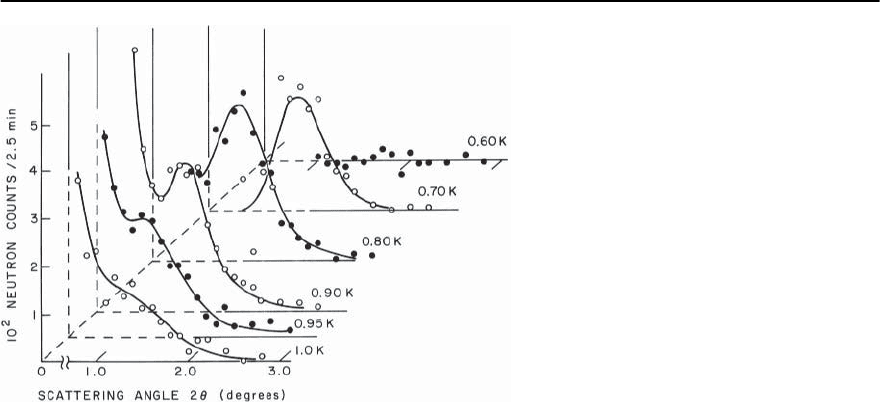
13 Unconventional Superconductivity in Novel Materials 655
Fig. 13.16. Small angle neutron scattering re-
sults on ErRh
4
B
4
obtained at various temper-
atures. The peak at 2 =1.4
◦
indicates an os-
cillatory magnetization with a wavelength of
100 Å, after [84]
also a shoulder in the heat capacity above T
c2
whose
originmay be attributableto the formationof a sinu-
soidally modulated magnetic state that coexists with
superconductivity that is discussed below.
Measurements of the normalized neutron scatter-
ing intensity of the [101] reflection for ErRh
4
B
4
[84]
indicate that the ferromagnetic transition is broad,
extending up to ∼ 1.4 K, well above the tempera-
ture of the reentrant superconducting transition at
T
c2
∼ 0.9 K. Also, there is definite thermal hystere-
sis between ∼ 0.8Kand∼ 1.4 K. The width of the
ferromagnetictransition hasbeen attributed toa dis-
tribution of effective Curie temperatures within the
material, while the hysteresis may be caused by the
nucleation of normal-ferromagnetic domains within
the temperature intervall between T
c2
and ∼ 1.4K.
The heat capacity data also reveal thermal hysteresis,
part of which appears to be associated with the for-
mation of ferromagnetic domains (between ∼ 0.9K
and ∼ 1.3 K), and part of which is due to the reen-
trant transition at T
c2
.
Neutron intensity vs scattering angle data at vari-
ous temperatures on a polycrystalline ErRh
4
B
4
sam-
ple, whose reentrant superconducting transition oc-
curs at ∼ 0.7 K, revealed the development of a peak
near 1
◦
which grows in intensity as the temperature
is decreased and then disappears abruptly when the
sample becomes normal below T
c2
(see Fig. 13.16).
The data were interpreted in terms of fluctuations
into astateinwhich the magnetizationis sinusoidally
modulated with a wavelength ∼ 100 Å that was
assumed to take the form of a spiral. Subsequently,
neutron scattering experiments on an ErRh
4
B
4
sin-
gle crystal were performed by Sinha et al. [86]. Their
findings are consistent with the neutron scattering
experiments on polycrystalline ErRh
4
B
4
by Monc-
ton et al. [84], but revealed that the sinusoidally-
modulated magnetic state is a transverse linearly po-
larized long-range magnetic state with a wavelength
of ∼ 100 Å. The linearly polarized sinusoidal mod-
ulation lies along the [010] axis and the propaga-
tion directions are at 45
◦
to the [001] and the [100]
axes.The neutron scattering measurements on a sin-
gle crystal of ErRh
4
B
4
are summarized in Fig. 13.17.
NeutrondiffractionexperimentsonaHoMo
6
S
8
single crystal by Rossat–Mignod et al. [89] revealed
that the wavelength of the sinusoidally modulated
phase is twice as large as observed in powdered spec-
imens and is transverse, with the moments oriented
along the [111] direction while the wave vector is
along the [110] direction.The large value ofthe wave-
length ( ∼ 570 Å at 0.1 K) and the existence of a
ferromagnetic phase in microdomains of the order
of 1000 Å to 1500 Å were taken as evidence that the
modulated phase is actually induced by the electro-
magnetic interaction between the persistent current
and the magnetic moments.
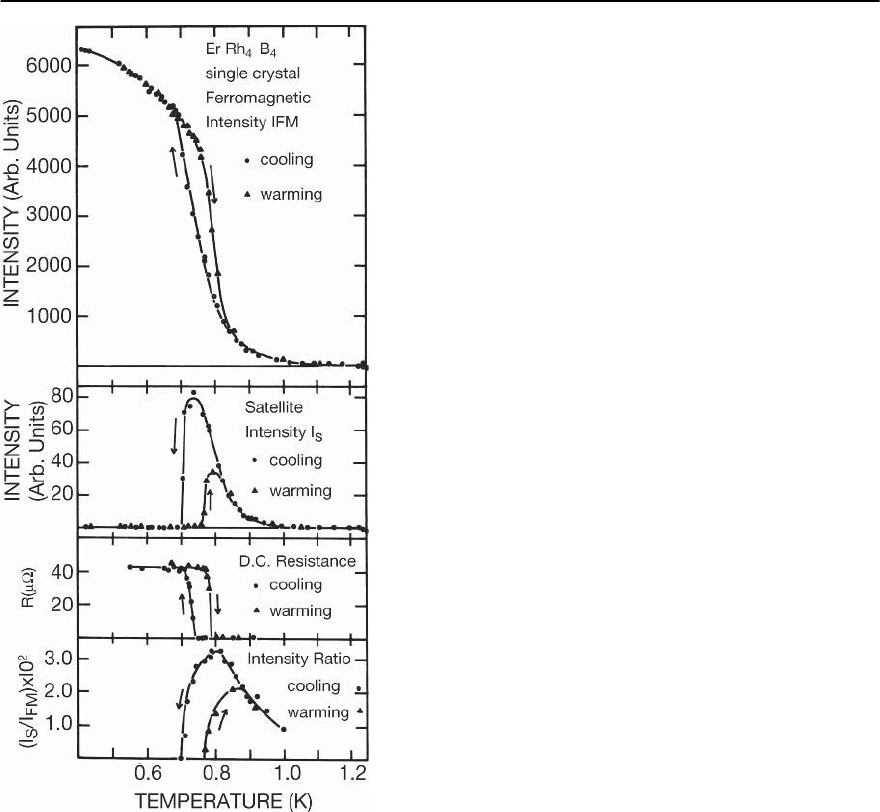
656 M.B. Maple et al.
Fig. 13.17. Temperature dependence of the ferromagnetic
intensity from the (101) Bragg peak, the satellite intensity,
the dc resistance of ErRh
4
B
4
and the ratio of the satellite to
the ferromagnetic intensity for the (101) reciprocal lattice
point, after [86]
The sinusoidally modulated magnetic state that
coexists with superconductivity in HoMo
6
S
8
and
ErRh
4
B
4
is reminiscent of the cryptoferromagnetic
state proposed by Anderson and Suhl [90] in 1959
and has been the subject of much theoretical inter-
est during the late 1970s and early 1980s. Whereas
the original theory of Anderson and Suhl is based
on the exchange interaction, more recent theories
such as those of Blount and Varma [91], Ferrell et
al. [92], and Matsumoto et al. [93] are based on the
electromagnetic interaction. Although, as discussed
earlier, the exchange interaction is operative in these
materials, the electromagnetic interaction appears to
be primarily responsible for the sinusoidally mod-
ulated magnetic state that coexists with supercon-
ductivity. Other possibilities for the periodic mag-
netic structure above T
c2
that have been considered
are (i) a spontaneous vortex lattice, (ii) a laminar
structure, stabilized by the R magnetization in a self-
consistent manner, and (iii) combined spiral mag-
netic and spontaneous vortex states [68].
Many other techniques have been applied to in-
vestigate the physical properties of HoMo
6
S
8
and
ErRh
4
B
4
,and the reader is referred to several reviews
on this subject that can be found in [8].
Superconductivity and Competing Magnetic
Interactions
Experiments on pseudoternary R compounds pro-
vide an alternative method for studying the inter-
action between superconductivity and long-range
magnetic order, as well as for exploring the effects
of competing types of magnetic moment anisotropy
and/or magnetic order. Two types of RRh
4
B
4
pseu-
doternarieshave been formed,one in whicha second
R element is substituted at the R sites, and another
in which a different transition element is substituted
at the Rh sites.
An example of the first type of pseudoternary
RRh
4
B
4
system is (Er
1−x
Ho
x
)Rh
4
B
4
whose low tem-
perature phase diagram, delineating the paramag-
netic, superconducting, and magnetically ordered
phases, is shown in Fig. 13.18. The phase bound-
aries have been determined from ac magnetic sus-
ceptibility [94,95] and neutron diffraction measure-
ments [96]. The phase diagram displays regions in
which the Er
3+
and Ho
3+
magnetic moments inde-
pendently order ferromagnetically within the basal
plane and along the tetragonal c-axis, respectively,
separated by a region of mixed magnetic phases. The
temperature interval above T
c2
within which the si-
nusoidally modulated magnetic phase in ErRh
4
B
4
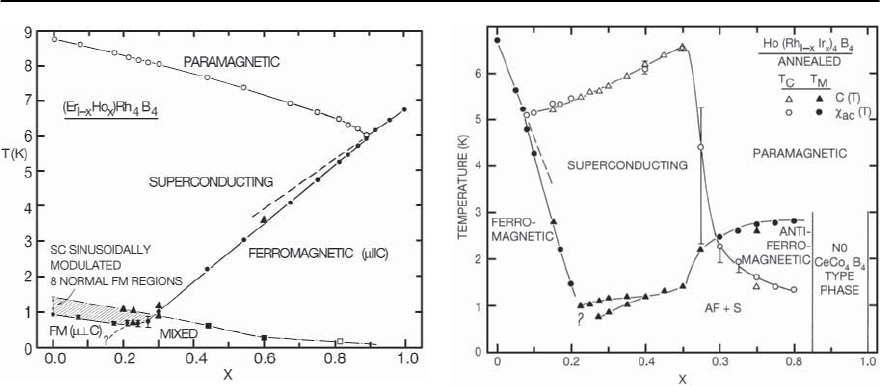
13 Unconventional Superconductivity in Novel Materials 657
Fig. 13.18. Low temperature phase diagram for the
(Er
1−x
Ho
x
)Rh
4
B
4
pseudoternary system, after [94–96]
coexists with normal ferromagnetic domains is also
indicated in Fig. 13.18. This inhomogeneous phase
presumably persists within a certain region in the
T − x plane (shaded area in the figure). There is a tri-
critical point at the concentration x
c
=0.89atwhich
T
c1
,T
c2
andT
M
becomecoincident.TheT
c2
vsx phase
boundary for x < x
c
is depressed relative to a linear
extrapolation of T
M
vs x for x > x
c
(dashed curve in
Fig. 13.18). Analysis of neutron diffraction data on
an (Er
0.4
Ho
0.6
)Rh
4
B
4
sample [97] indicates that the
actual T
M
of 3.67 K is about 0.2 K less than it would
have been in the absence of superconductivity, inac-
cord with the dashed-line extrapolation as well as
theoretical predictions.
A striking example of the second type of pseu-
doternary RRh
4
B
4
system is Ho(Rh
1−x
Ir
x
)
4
B
4
.This
system was first investigated by Ku et al. [99] and
provided evidence for the coexistence of supercon-
ductivity and antiferromagnetic order with T
N
> T
c
for x > 0.6. Subsequently, several detailed investi-
gations of a Ho(Rh
0.3
Ir
0.7
)
4
B
4
compound were car-
ried out; heat capacity measurements [88] confirmed
the bulk character of the antiferromagnetic order
in this material, while neutron diffraction experi-
ments [100] revealedthe magnetic structure.The low
temperature phase diagram of the Ho(Rh
1−x
Ir
x
)
4
B
4
system [94, 98], based on low temperature specific
heat, ac magnetic susceptibility,and electrical resis-
Fig. 13.19. Low temperature phase diagram for the
Ho(Rh
1−x
Ir
x
)
4
B
4
pseudoternary system, after [94,98]
tance measurements, is shown in Fig. 13.19. The first
study of this system yielded a similar phase diagram,
but with no evidence for magnetic ordering at tem-
peratures T > 1.2 K for 0.2 < x < 0.6.
Several other pseudoternary RRh
4
B
4
systems have
been investigated, and the reader is referred to more
comprehensive reviews for discussion and refer-
ences [8,13].
13.2.4 Magnetic Field Induced Superconductivity
One of the most dramatic manifestations of the inter-
action between superconductivity and magnetism is
the induction of superconductivity through the ap-
plication of a high magnetic field. The mechanism
that is apparently responsible for this phenomenon,
referred to as the exchange field compensation ef-
fect, was proposed by Jaccarino and Peter [4] more
than 20 years before magnetic field induced super-
conductivity (MFIS) was firmly established experi-
mentally [101].
The best example of MFIS is illustrated in
Fig. 13.20 which shows H
c2
vs T for the compound
Eu
0.75
Sn
0.25
Mo
6
S
7.2
Se
0.8
,taken from the work of Meul
et al. [101]. The normalized electrical resistance
(R/R
N
) vs applied magnetic field H at several tem-
peratures is displayed in the inset of Fig. 13.20. At
the lowest temperature (0.37 K), the data reveal a se-
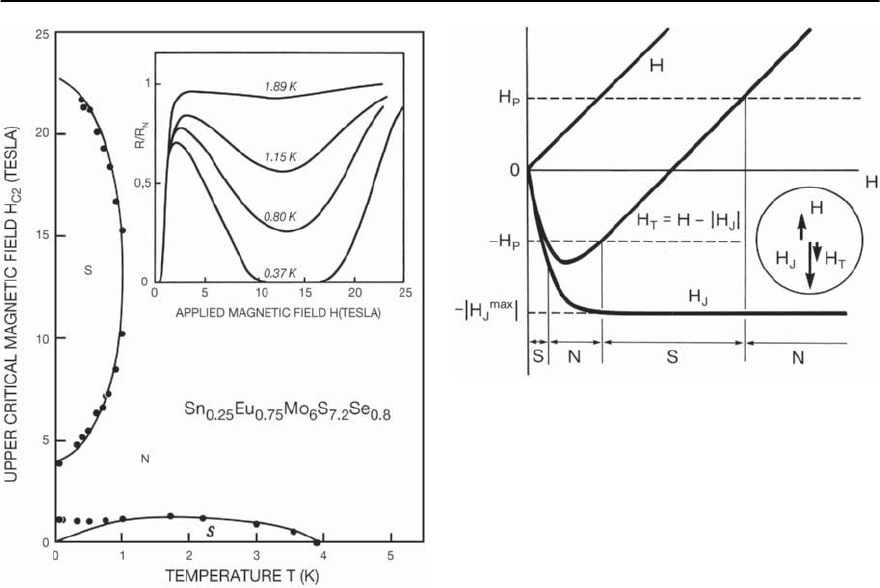
658 M.B. Maple et al.
Fig. 13.20. Magnetic field H − temperature T phase dia-
gram for the compound Eu
0.75
Sn
0.25
Mo
6
S
7.2
Se
0.8
.Thesym-
bols S and N denote superconducting and normal regions,
respectively. The solid circles represent the H
c2
(T)mea-
surements of Meul et al. [101], and the solid lines are the
boundaries predicted by theory. Normalized electrical re-
sistance R/R
N
, vs applied magnetic field data at several
temperatures are shown in the inset,after [101]
quence of transitions with increasing magnetic field
H from superconducting to normal, to supercon-
ducting again, and, finally, back to normal (S–N–S–
N). From a series of measurements of R/R
N
vs H at
various temperatures,the phase diagram in the H −T
plane was constructed (Fig. 13.20); two separate do-
mains of superconductivity are found, one at low
fields and another at high fields, whereas only one
domain of superconductivity at low fields is present
for a conventional superconductor.
MFIS occurs in type II superconductors in which
H
c2
(T) is determined by the paramagnetic limiting
field H
p
and which contain magnetic moments that
are antiferromagnetically coupled to the spins of the
Fig. 13.21. Schematic diagram of the S–N–S–N transition
sequence in an applied magnetic field H.H
T
is the net mag-
netic field acting on the conduction electron spins,H
J
is the
exchange field produced by localized magnetic moments,
and H
p
is the paramagnetic limiting field. The material is
superconducting (S) when |H
J
| < H
p
and normal (N) when
|H
T
| > H
p
, after [11]
conduction electrons. The magnetic moments in the
Eu
x
Sn
1−x
Mo
6
S
8−y
Se
y
compounds are carried by the
divalent Eu ions and their coupling to the conduc-
tion electron spins generates an “effective” magnetic
field, the exchange field H
J
, that acts on the conduc-
tion electron spins in the same manner as an applied
magnetic field.If the sign of the coupling between the
Eu magnetic moments and the conduction electron
spins is negative, the direction of H will be opposite
to that of H
J
; i.e., the effect of H
J
will be “compen-
sated” by H (see inset of Fig. 13.21). The net mag-
netic field H
T
is then given by H
T
= H − |H
J
|.The
sequence of S–N–S–N transitions shown in the inset
of Fig.13.20 can be explainedin termsof therelation-
ship between H
T
and H
p
as illustrated schematically
in Fig. 13.21 [11]. The upper and lower curves show
the applied field H and the exchange field H
J
,respec-
tively, the sum of which yields the net magnetic field
H
T
.ThevariationofH
T
with respect to the value of
H determines the superconducting behavior of the
material.
In zero applied field, the compound is supercon-
ducting. As the applied magnetic field is increased,
the Eu magnetic moments become aligned in the di-

13 Unconventional Superconductivity in Novel Materials 659
rection of the field at a relatively low H-value and
|H
J
| attains its maximum value |J
max
| of 30–50 tesla.
Consequently, provided |H
J
| is greater than H
p
,the
magnitude of H
T
(which is now negative) can become
larger than H
p
and drive the material into the nor-
mal state. As the applied magnetic field is increased
further, the net magnetic field starts to decrease in
magnitude, until its magnitude falls below H
p
when
the compound once more becomes superconducting.
Thereafter, H
T
increases linearly with H,vanishing
and then changing sign at H = |H
max
J
| where H
J
is
completely compensated, until H
T
(now positive) ex-
ceeds H
p
, when the system once again becomes nor-
mal. Because the value of the exchange field can be
rather large, the compensation effect can take place
at very high magnetic fields.
In actuality,the second transition from supercon-
ductivity to the normal state will also occur if H
surpasses the orbital critical field H
∗
c2
of the com-
pound. Thus, in order to observe MFIS, it is impor-
tant that H
∗
c2
, which can also limit the value of the
upper critical field H
c2
, is large enough to allow su-
perconductivity to occur in this magnetic field range
(that is,H
∗
c2
> |H
max
J
| − H
p
), since the orbital effects
are not compensated by the Jaccarino–Peter mecha-
nism. The compensation of the exchange field by the
applied magnetic field in several Eu
x
M
1−x
Mo
6
S
8
sys-
tems (where M is a metal such as Sn, Pb, La [102] or
Yb [103]) and in EuMo
6
S
8
under pressure [104], had
been inferred from an enhancement and anomalous
temperature dependence of H
c2
in these materials.
Following the initial suggestion by Jaccarino and
Peter that MFIS could occur in a ferromagnet due to
exchange field compensation, several theoretical in-
vestigations of MFIS in paramagnetic systems were
carried out [105–107].One model, based on the the-
ory of type II superconductivity including the ef-
fect of the exchange field [106], was used by Meul
et al. to analyze their H
c2
(T)measurementsonthe
Eu
x
Sn
1−x
Mo
6
S
8
system.The calculated boundaries of
the two superconducting domains observed for the
compound Eu
0.75
Sn
0.25
Mo
6
S
7.2
Se
0.8
are indicated by
the solid lines in Fig. 13.20 where the parameters of
the theory have been adjusted to give the best fit to
thedata.TheexcellentdescriptionoftheH − T su-
perconducting phase boundaries shown in Fig. 13.20
is striking confirmation of the Jaccarino–Peter com-
pensation mechanism.Jaccarino and Peter originally
suggested MFIS in a weakly ferromagnetic material,
assuming that it would be superconducting in the
absence of ferromagnetic ordering. MFIS in a ferro-
magnet remains to be discovered.
13.3 f -Electron Heavy Fermion
Superconductors
13.3.1 Introduction
In heavy-fermion compounds, strong electronic in-
teractions between the conduction electrons and
the localized f -electrons of rare earth or actinide
ions result in large quasiparticle effective masses,
up to several hundred times the free-electron mass.
These compounds display a wide variety of strik-
ing correlated-electron phenomena including va-
lence fluctuations, the Kondo effect, magnetic order,
non-Fermi liquidbehavior,and,of course,supercon-
ductivity.
As discussed in Sect. 13.2, magnetic moments in
conventional superconductors suppress and eventu-
ally destroy superconductivity with increasing con-
centration of magnetic ions. In fact, for decades it
was generally accepted that magnetism and super-
conductivity were inimical. Thus, the 1979 discov-
ery of superconductivity in the heavy-fermion com-
pound CeCu
2
Si
2
[108], in which the sublattice of Ce
ions possess well-defined local moments at high tem-
peratures, posed a major puzzle to researchers. Since
then,the list of superconducting heavy-fermion com-
pounds has expanded to include about twenty Ce,
U, Pu, and Pr-based compounds. The known heavy
fermion f -electron superconductors and their crys-
tal structure and lattice parameters are listed in Ta-
ble 13.1.Many of these compounds display the coex-
istence of antiferromagnetism (AFM) and supercon-
ductivity, and, recently, ferromagnetic superconduc-
tors have been added to the list (UGe
2
[3], URhGe
[109]).
The study of superconductivity in heavy-fermion
compounds has led to a range of unexpected phe-
nomena and new theories. It is now widely suspected
that heavy-fermion superconductivity (HFSC) is

660 M.B. Maple et al.
Table 13.1.Crystal structure and lattice parameters of heavy-fermion superconductors
Compound Structure Type Lattice Parameters (Å) Ref.
abc
CeCu
2
Si
2
ThCr
2
Si
2
(Tetr. I4/mmm) 4.103 9.94 [110]
CePd
2
Si
2
ThCr
2
Si
2
(Tetr. I4/mmm) 4.24 9.88 [111]
CeRh
2
Si
2
ThCr
2
Si
2
(Tetr. I4/mmm) 4.09 10.18 [111]
CeNi
2
Ge
2
ThCr
2
Si
2
(Tetr. I4/mmm) 4.150 9.854 [112]
CeCu
2
Ge
2
ThCr
2
Si
2
(Tetr. I4/mmm) 4.18 10.18 [113]
CeIn
3
AuCu
3
(Cub. Pm3m) 4.689 [114]
CeRhIn
5
HoCoGa
5
(Tetr. P4/mmm) 4.652 7.542 [115]
CeIrIn
5
HoCoGa
5
(Tetr. P4/mmm) 4.668 7.515 [116]
CeCoIn
5
HoCoGa
5
(Tetr. P4/mmm) 4.62 7.56 [117]
Ce
2
RhIn
8
Ho
2
CoGa
8
(Tetr. P4/mmm) 4.665 12.244 [118]
CePt
3
Si CePt
3
B(Tetr.P4mm) 4.072 5.442 [119]
CeRhSi
3
BaNiSn
3
(Tetr. I4/mm) 4.269 9.738 [120]
CeIrSi
3
BaNiSn
3
(Tetr. I4/mm) 4.252 9.715 [120]
CeNiGe
3
SmNiGe
3
(Ortho. Cmmm) 21.808 4.135 4.168 [121]
Ce
2
Ni
3
Ge
5
U
2
Co
3
Si
5
(Ortho. Ibam) 9.809 11.838 5.960 [122]
PrOs
4
Sb
12
LaFe
4
P
12
(Cub. Im
¯
3) 9.3017 [123]
UBe
13
NaZn
13
(Cub. Fm
¯
3c) 10.268 [124]
UPt
3
SnNi
3
(Hex. P6
3
/mmc ) 5.764 4.899 [125]
URu
2
Si
2
ThCr
2
Si
2
(Tetr. I4/mmm) 4.121 9.681 [126]
UPd
2
Al
3
PrNi
2
Al
3
(Hex. P6/mmm) 5.365 4.186 [127]
UNi
2
Al
3
PrNi
2
Al
3
(Hex. P6/mmm) 5.207 4.018 [128]
UGe
2
ZrGa
2
(Orth. Cmmm) 4.036 14.928 4.116 [129]
UIr PdBi (Mono. P2
1
) 5.620 10.590 5.598 (ˇ =89.93
◦
) [130]
URhGe TiNiSi (Orth. Pnma) 6.855 4.327 7.501 [131]
U
6
Fe Mn
6
Fe (Tetr. I4/mcm) 10.302 5.239 [132]
PuCoGa
5
HoCoGa
5
(Tetr. P4/mmm) 4.232 6.786 [133]
PuRhGa
5
HoCoGa
5
(Tetr. P4/mmm) 4.301 6.857 [134]
magnetically mediated, with an unconventional su-
perconducting order parameter (p or d-wave sym-
metry) that vanishes at lines or points on the Fermi
surface. In UPt
3
and U
1−x
Th
x
Be
13
, multiple super-
conducting phases are observed which is evidence
for a complex, multicomponent superconducting
order parameter. Very recently, superconductivity
was discovered [123, 135] in PrOs
4
Sb
12
,inwhich
the superconductivity may be mediated by electric
quadrupolar interactions ratherthan magnetic inter-
actions of the Pr ions, suggesting a new mechanism
for superconductivity in heavy fermion systems. Two
decades later, the question of how superconductivity
and magnetism can coexist still remains a formidable
challenge and further research into this subject will
no doubt greatly expand our understanding of su-
perconductivity.
In this section, we briefly review the normal and
superconducting properties of heavy-fermion super-
conductors, in general.We then focus on a few exem-
plary compounds such as the CeMIn
5
(M = Rh, Co,
Ir), UGe
2
,andPrOs
4
Sb
12
. The compound UPd
2
Al
3
